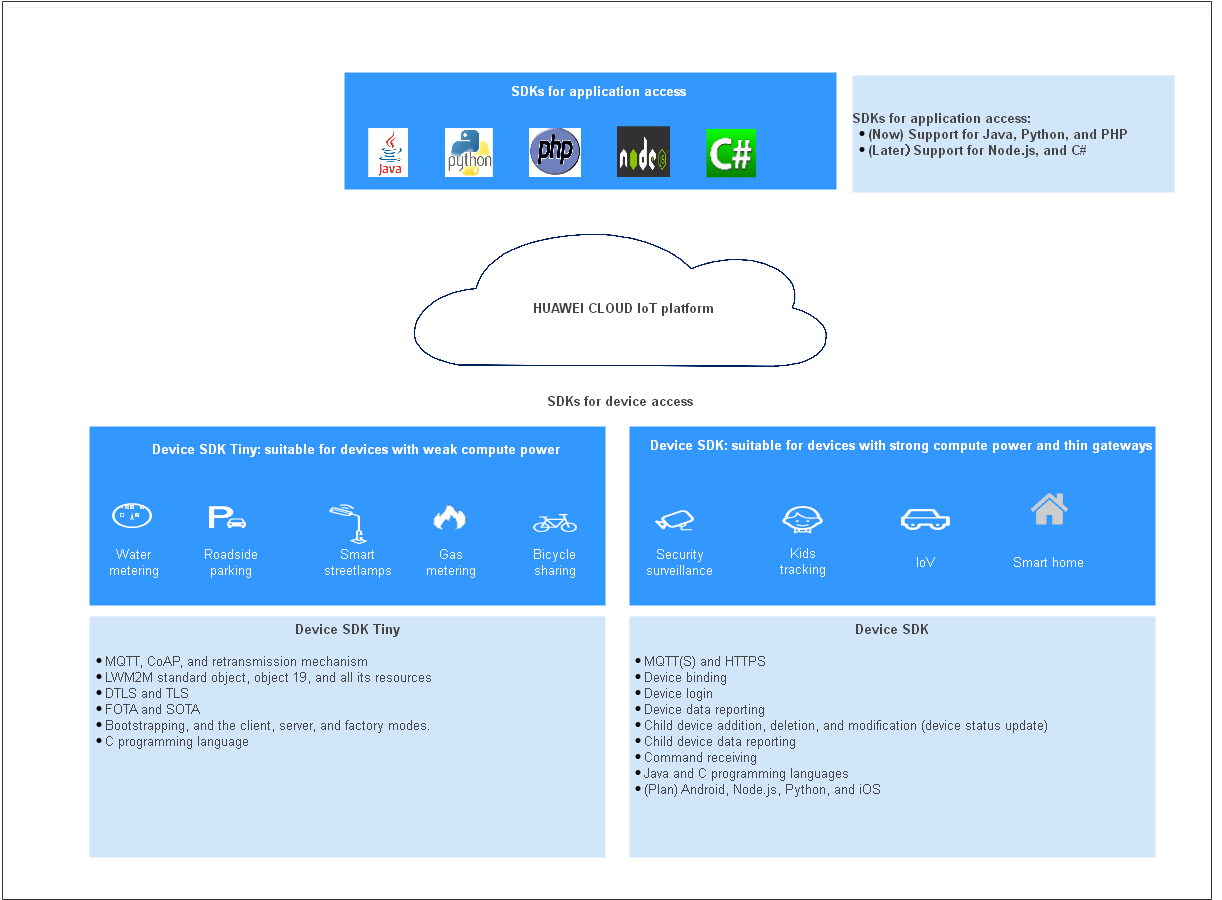Introduction to IoT Device SDKs
You can use Huawei IoT Device SDKs to quickly connect devices to the IoT platform. After being integrated with an IoT Device SDK, devices that support the TCP/IP protocol stack can directly communicate with the platform. Devices that do not support the TCP/IP protocol stack, such as Bluetooth and ZigBee devices, need to use a gateway integrated with the IoT Device SDK to communicate with the platform.

- Create a product on the IoTDA console or by calling the API Creating a Product.
- Register a device on the IoTDA console or by calling the API Creating a Device.
- Implement the functions demonstrated in the preceding figure, including reporting messages/properties, receiving commands/properties/messages, OTA upgrades, topic customization, and generic-protocol access (see Developing a Protocol Conversion Gateway for Access of Generic-Protocol Devices).
The platform provides two types of SDKs. The table below describes their differences.
|
SDK Type |
Pre-integration Solution |
IoT Protocols Supported |
|---|---|---|
|
IoT Device SDK |
Embedded devices with strong computing and storage capabilities, such as gateways and collectors |
MQTT |
|
IoT Device SDK Tiny |
Devices that have strict restrictions on power consumption, storage, and computing resources, such as single-chip microcomputer and modules |
LwM2M over CoAP and MQTT |
The table below describes hardware requirements for devices.
|
SDK |
RAM Capacity |
Flash Memory |
CPU Frequency |
OS Type |
Programming Language |
|---|---|---|---|---|---|
|
IoT Device SDK |
> 4 MB |
> 2 MB |
> 200 MHz |
C (Linux), Java (Linux/Windows), C# (Windows), Android (Android), Go Community Edition (Linux/Windows/Unix-like OS), and OpenHarmony |
C, Java, C#, Android, and Go |
|
IoT Device SDK Tiny |
> 32 KB |
> 128 KB |
> 100 MHz |
It adapts to LiteOS, Linux, macOS, and FreeRTOS. You can modify the SDK to adapt to other environments. |
C |

For details on the SDK usage, visit the following links:
- IoT Device SDK (C#)
- IoT Device SDK (Android)
- IoT Device SDK (Go Community Edition)
- IoT Device SDK Tiny (C)
- IoT Device SDK (Python)
The following table shows the main function matrix of the SDK.
|
Function |
C |
Java |
C# |
Android |
Go |
Python |
C Tiny |
|---|---|---|---|---|---|---|---|
|
Property reporting |
√ |
√ |
√ |
√ |
√ |
√ |
√ |
|
Message reporting and delivery |
√ |
√ |
√ |
√ |
√ |
√ |
√ |
|
Event reporting and delivery |
√ |
√ |
√ |
√ |
√ |
√ |
√ |
|
Command delivery and response |
√ |
√ |
√ |
√ |
√ |
√ |
√ |
|
Device shadow |
√ |
√ |
√ |
√ |
√ |
√ |
√ |
|
OTA upgrade |
√ |
√ |
√ |
√ |
√ |
√ |
√ |
|
bootstrap |
√ |
√ |
√ |
√ |
√ |
√ |
√ |
|
Time synchronization |
√ |
√ |
√ |
√ |
√ |
√ |
√ |
|
Gateway and child device management |
√ |
√ |
√ |
√ |
√ |
√ |
√ |
|
Device-side Rules |
√ |
× |
√ |
× |
× |
× |
√ |
|
Remote SSH |
√ |
× |
√ |
× |
× |
× |
× |
|
Anomaly detection |
√ |
× |
√ |
× |
× |
× |
× |
|
Device-cloud secure communication (soft bus) |
√ |
× |
√ |
× |
× |
× |
× |
|
M2M function |
√ |
× |
√ |
× |
× |
× |
× |
|
Generic-protocol access |
√ |
√ |
√ |
√ |
× |
√ |
× |
Feedback
Was this page helpful?
Provide feedbackThank you very much for your feedback. We will continue working to improve the documentation.See the reply and handling status in My Cloud VOC.
For any further questions, feel free to contact us through the chatbot.
Chatbot





